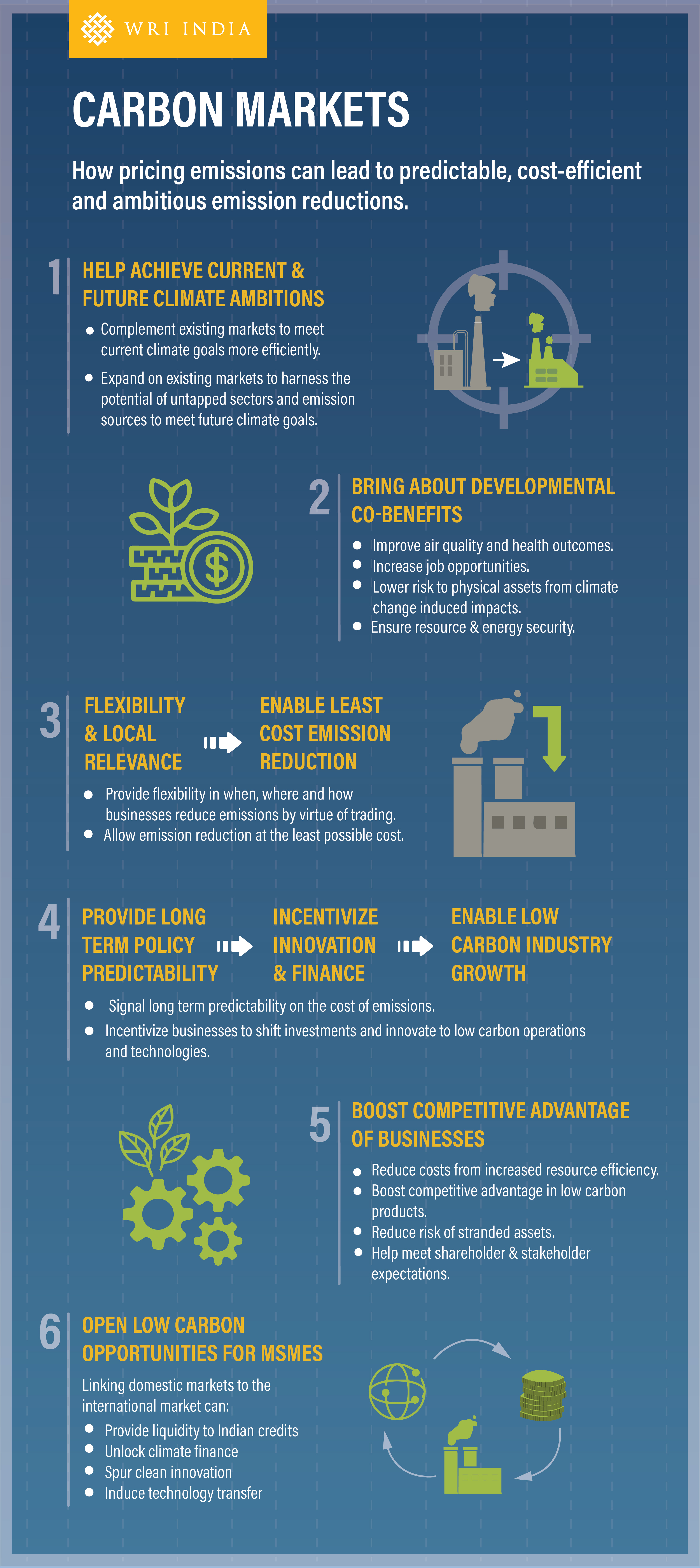
Five ways in which Carbon Markets can boost India’s climate efforts
This is the first blog in a new series on carbon markets in India. In this blog series, we will share insights from WRI India’s corporate carbon market simulation in which more than 20 leading Indian companies participated during 2020-2021.
In December 2020, the Government of India constituted an Apex Committee to oversee India’s Implementation of the Paris Agreement. This Apex Committee, which brings together 13 different Union ministries, will function as the national authority to regulate carbon markets in India.
Economists overwhelmingly agree that carbon markets can cost-effectively deliver emission reductions. A carbon market puts a cap on the total emissions in a region or system. but allows flexibility to achieve that cap through trading among entities within that region or system. In fact, 39 national and 29 subnational jurisdictions--covering 17% of global GHG emissions--have already implemented or are scheduled to implement a carbon market.

Content & Design: Rhea Antony, Shubhangi Gupta and Ashwini Hingne
Here are five ways in which carbon markets can support and boost India’s climate efforts:
1. Carbon markets can help India meet its current and future climate ambitions
India has a rich experience in global carbon markets through the Clean Development Mechanism under the Kyoto Protocol. India can build on its experience along with existing domestic market mechanisms like the Performance, Achieve and Trade (PAT) and Renewable Energy Certificates (REC) to develop a carbon market. Such a carbon market can supplement existing policies by covering sectors not already covered such as waste management, Micro Small and Medium Enterprises (MSMEs), banking, etc. A carbon market can harness untapped emission reduction potential, encourage efficiencies in these industries and synthesize the different markets through a common carbon currency.
The dynamic ratchet mechanism under the Paris Agreement requires countries to submit new commitments, with higher ambition, every five years. A carbon market can help India meet such progressive ambitions by complementing and supporting reductions from targeted sectors in a cost-efficient manner.
2. Co-benefits from carbon markets can help meet India’s developmental goals
The underlying principle of putting a price on carbon is to make emitting costlier and to level the playing field between fossil fuels and cleaner alternatives. It can make clean energy cheaper and more profitable in the long run, thereby supporting India’s renewable energy goals. In addition, measures to reduce GHG emissions can also reduce emissions of particulate matter. Therefore, carbon markets can also facilitate co-benefits in other priority areas for India such as reducing air pollution and its associated health costs. Measures to reduce emissions can also contribute to improving resource and energy efficiency. Finally, a carbon market that helps mitigate emissions would also lower India’s future physical and ecological climate costs. Therefore, carbon markets can also help accelerate India’s progress on Sustainable Development Goals (SDGs) of Affordable and Clean Energy (SDG 7), Responsible Consumption and Production (SDG 12), Good Health and Wellbeing (Goal 3) and Industry, Innovation and Infrastructure (Goal 9) along with Climate Action(SDG 13).
3. Carbon markets offer lowest cost emission reductions
Carbon markets incentivize entities with low reduction costs to reduce emissions beyond their mandate. It further provides flexibility to entities with high reduction costs to supplement their own reduction efforts with lower cost reductions from the market. Such trading within a carbon market thus reduces the overall cost of emission reductions at the societal level. Therefore, carbon markets can help India achieve its India’s climate ambitions and mitigate its climate risks in a cost-effective manner.
4. Carbon markets can enable low-carbon industry growth
A well-designed carbon market offers medium to long-term price signals to companies and investors on the cost of emissions. In addition, floor prices for trading provide a minimum certainty on the value of reductions achieved. These economic signals provide clarity and predictability for businesses to implement progressive mitigation measures, invest in low carbon technologies, reduce emissions across their supply chains and develop sustainable products. This would also encourage a transition towards clean energy, infrastructure, and resource efficiency, thus setting Indian industry on a low-carbon and sustainable growth path.
5. Carbon markets can allow Indian entities to contribute to global emission reductions
Article 6 of the Paris Agreement enables and encourages domestic and international market mechanisms to meet the Nationally Determined Contributions (NDCs), drive climate finance and transfer low -carbon technology and enhance global ambition on mitigating emissions.
A well designed, robust carbon market can also enable India to participate effectively in a globally interlinked carbon market. It can spur innovation and finance clean projects from Indian MSMEs, who offer significant emission reduction potential and are an integral part of Indian industry. They can also provide greater liquidity to reduction certificates from India, thus encouraging greater reductions at a global level.